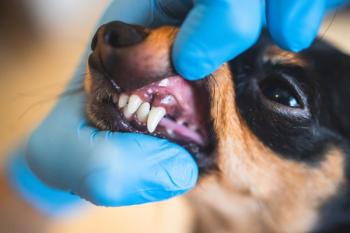
Analgesics for oral surgery in dogs and cats
Six of the most common agents used for managing pain associated with oral surgery in dogs and cats will be discussed in this third article of a series on pain management. They are the opioids (opiates), the Cox-2 selective non-steroidal anti-inflammatory drugs (NSAIDS), the 5-Lox selective NSAIDs, the alpha-2 agonists, the NMDA-receptor antagonists and the serotonin norepinephrine reuptake inhibitors.
Six of the most common agents used for managing pain associated with oral surgery in dogs and cats will be discussed in this third article of a series on pain management. They are the opioids (opiates), the Cox-2 selective non-steroidal anti-inflammatory drugs (NSAIDS), the 5-Lox selective NSAIDs, the alpha-2 agonists, the NMDA-receptor antagonists and the serotonin norepinephrine reuptake inhibitors.
Products
Opioids
The opioid group provides the most effective analgesia available for preoperative, perioperative and postoperative pain control in dogs and cats. It is important to understand several characteristics of opioids to enable the clinician to make decisions on which agents would best be suited for use in a particular patient. Drugs in this class produce variable clinical effects based on stimulation of a particular opioid receptor subtype (Table 1). The characteristics of individual opioids determine their effect at a given receptor (Table 2). Selective effects of common opioids on different receptors vary as well (Table 3). An individual opiate's ability to bind preferentially to a given receptor is termed receptor affinity. These different classes of opiates are listed in decreasing order of receptor affinity: antagonist > partial agonist/mixed agonist antagonist > agonist.
Table 1: Opiod-receptor subtypes
A full understanding of these concepts aids the clinician in choosing the correct opiate or combination of opiates based upon the species, and the degree and duration of the anticipated pain. Opiate receptors are located throughout the body and are concentrated in the central and peripheral nervous system, making the agents that bind to them invaluable analgesics.
Table 2: Definitions of opioid-receptor activity with examples of common agents in each class.
It is widely understood that mu opioid-receptor stimulation results in the most significant analgesic effect beyond that of any other receptor subtype. Research in this field has led to the ability to clone the mu, kappa and delta opiate receptors. Knockout mice that lack specific opiate receptor genes give researchers the ability to study the effects of different opiates on receptor subtypes.
Table 3: Selectivity for opiod-receptor subtypes
The prototype agent in the opioid category is morphine. It is the drug of choice for severe acute pain in dogs. Cats have been known to experience more of the undesirable effects at the sigma receptor (Table 1) with administration of morphine. Studies suggest it is likely that the dysphoric effects were due to unusually high doses used in research settings. Evidence now suggests that opiates actually convey euphoric effects in cats when used at lower doses.
In the author's extensive experience with pre-operative morphine in cats, dysphoria and excitation appear to be an issue mostly post-operatively. In that respect, consideration must be given to the combination of agents administered in the preoperative, induction and intraoperative periods combining to exacerbate the expected degree of recovery disillusionment.
Hyperthermia in cats with the use of opiates is predictable and therefore monitoring is essential. Patients should be monitored during the anesthetic period and up to five hours during post procedure. If hyperthermia becomes significant, reversal agents that are mu antagonists can be administered. Butorphanol and nalbuphine are kappa-receptor agonists. That property provides some residual analgesia when they are used as mu antagonists to reverse morphine. Naloxone is an antagonist at the mu, kappa and gamma receptors, so administration of this reversal agent provides no residual analgesia.
Suggested Reading
Morphine, in particular, will cause vomiting in a significant number of patients. A decrease in incidence occurs with intravenous administration. Histamine release is a problem with rapid administration, so morphine given IV must be given slowly over a period of 30 seconds. An alternative to morphine in cats is hydromorphone that is an excellent analgesic in this species. Intravenous administration of hydromorphone in cats provides quicker onset, increased intensity and longer duration with a decreased incidence of vomiting than IM or SQ administration. Again, hyperthermia is a concern, so monitoring temperature is essential.
Oral-surgery patients may be painful and difficult to medicate post-operatively per os. Fentanyl transdermal patches are viable options for managing postoperative pain in dogs and cats undergoing oral surgical procedures. The onset of effect in dogs and cats is 18 to 24 hours and six to 12 hours, respectively. If using fentanyl patches, the void between placement and onset of action should be adequately covered with additional analgesics.
Butorphanol is an mu antagonist allowing for only minimal control of somatic pain. It is expensive and frequent dosing is required due to its short half-life. Consequently it is a poor choice for managing pain associated with oral surgery.
Buprenorphine has partial agonist activity at the mu receptor and consequently less profound analgesic properties than would a pure agonist. However, it is a safe and effective analgesic and is a great option for use in cats sublingually and transdermally. It is a good choice when anticipating mild to moderate postoperative pain.
Cox-2 Selective NSAIDs
The breakdown of arachidonic acid by cyclooxygenase (Cox) enzymes produces prostaglandins. These proinflammatory compounds are released from various cell types at the site of tissue injury. Other compounds, including cytokines and growth factors, aid in stimulating the production of additional prostaglandins. Prostaglandins sensitize afferent neurons to noxious chemical, thermal and mechanical stimuli and play a major role in the process of maintaining inflammation.
Prostaglandins are involved at the site of inflammation and play a significant role at the spinal level. Peripheral inflammation upregulates cyclooxygenase enzyme expression in the spinal cord. Therefore, drugs that can prevent the prostaglandin production can be used to decrease this phenomenon. This may be particularly effective when given preoperatively prior to surgical stimulation.
The non-steroidal anti-inflammatory drugs (NSAIDs) inhibit Cox enzymes. Their use allows for effective treatment of pain and hyperalgesia associated with inflammation. Cyclooxygenase-2 (Cox-2) selective NSAIDs have been widely used in veterinary medicine as analgesics. Adverse effects consistently experienced with earlier NSAIDs are nowhere near as significant with these newer agents. Adverse effects are still possible, however. NSAIDs as sole agents for analgesia can be effective; however, using multiple agents in a multimodal approach offers safety and efficacy beyond that of single agents. An NSAID in combination with an opiate in humans has demonstrated opioid sparing effects in the range of 20 percent to 30 percent. To date no Cox-2 selective NSAID approved for use in veterinary medicine has been shown to demonstrate significant advantages over another.
5-Lox selective NSAIDs
Arachidonic acid breakdown by 5-lipoxygenase (5-Lox) produces leukotrienes that, like prostaglandins, significantly affect the inflammatory process. Both classes work together, synergistically potentiating the inflammatory cascade. The combination of Cox-2 and 5-Lox pathway inhibition could theoretically enhance the anti-inflammatory effect on tissue. The NSAID tepoxalin, approved for use in dogs, demonstrates Cox-1, Cox-2 and 5-Lox inhibition. This agent has not been shown to demonstrate significant advantages over Cox-2 inhibition alone and bleeding may be an issue due to its Cox-1 effect.
Alpha2 agonists
Alpha2 agonists involve mechanisms associated with the activation of guanine nucleotide binding proteins (G proteins) that modulate intracellular second messenger systems. G-protein activation of these second messenger systems produces a complex cascade of events that results in both beneficial and detrimental physiologic effects. These include sedation, analgesia, increased systemic vascular resistance, bradycardia, respiratory depression and vomition. Xylazine is the prototypical drug in this class and carries the reputation for negative side effects.
With the introduction of the alpha-agonist medetomidine, many of these side effects have been minimized. This agent currently is being used in combination with opiates in doses of 5 to 20 mcg/kg to provide effective sedation and analgesia. However, due to the negative physiologic effects of this agent, it should only be used if blood pressure, end tidal CO2, SPO2 and EKG can be monitored. Doses above 20 mcg/kg contribute considerably to medotomidine's adverse effects. Atipamezole is an alpha-agonist reversal agent and is used to reverse the action of medotomidine.
Controversy exists surrounding the practice of administration of an anticholinergic in conjunction with medetomidine to offset bradycardia. It is believed that the initial reflex tachycardia seen with atropine combined with the increased cardiac afterload associated with increased systemic vascular resistance may result in cardiac compromise. A full review of medetomidine is beyond the purpose of this discussion. Additional references should be consulted prior to its use.
N-methyl-D-aspartate (NMDA) receptor antagonists
The pathophysiology of central sensitization was discussed in the first article of this series (DVM Newsmagazine, Aug. 2007;
Agents in this class act by competitively binding to the NMDA receptor and preventing central sensitization. Central sensitization occurs with activation of the glutamate and aspartate receptors resulting in accentuation in pain perception. Ketamine antagonizes the NMDA receptor in microdoses in conjunction with a constant-rate infusion. Further discussion follows in the section on constant-rate infusions.
Dextromethorphan, an antitussive and amantadine, an antiviral agent are both orally administered NMDA-receptor antagonists. Currently used in dogs and cats for the treatment of chronic pain and to minimize central sensitization, they may have particular application to decreasing central sensitization in chronic pain states prior to surgical manipulation. Neither is a particularly good analgesic when used alone; however, combining them with an opiate and/or an NSAID seems to provide safe and effective analgesia when indicated.
Amantidine is available in 100-mg capsules and a 10-mg/ml liquid. It can be administered once daily at a dose of 3 to 5 mg/kg for dogs and cats. Dextromethorphan is an active ingredient in Vick's Formula 44 cough syrup and Robitussin DM capsules. At 2.0 mg/kg it has been determined safe for treatment of dogs with allergic dermatitis. In cats, lower doses have been used; however, it appears to be poorly accepted making amantidine better choice in this species.
Serotonin/norepinephrine reuptake Inhibitors
Tramadol acts to alleviate pain centrally by inhibiting the reuptake of two inhibitory neurotransmitters, serotonin and norepinephrine, allowing them to remain in the synapse to exert their positive effects. Tramadol is not an opioid but has been shown to possess weak mu-agonist activity. It is available in 50-mg tablets and dosed at 2.5–10 mg/kg SID-TID in dogs and cats.
Pre-emptive administration of Tramadol with morphine has been proven to be safe at a dose of 2.0 mg/kg. It currently is used for chronic and postoperative pain management in a multimodal approach with opioids and NSAIDs. Tricyclic antidepressants, selective serotonin reuptake inhibitors and monoamine oxidase inhibitors should not be used concurrently with Tramadol due to the risk of serotonin syndrome.
A variety of analgesics are available for use in dogs and cats undergoing oral surgical procedures. Multimodal pain management uses these agents in combination to target specific anatomic regions and proalgesic mechanisms to customize and fine-tune their analgesic effects. Familiarization with these and other agents allows the practitioner to maximize pre-and post-operative comfort.
Brett Beckman
Brett Beckman, DVM, FAVD, Dipl. AVDC practices referral dentistry at Affiliated Veterinary Specialists, Orlando, Fla.; Noah's Animal Hospitals in Indianapolis; and at Florida Veterinary Dentistry and Oral Surgery in Punta Gorda, Fla. He is president-elect of the American Veterinary Dental Society and diplomate of the American Academy of Pain Management.
Newsletter
From exam room tips to practice management insights, get trusted veterinary news delivered straight to your inbox—subscribe to dvm360.






